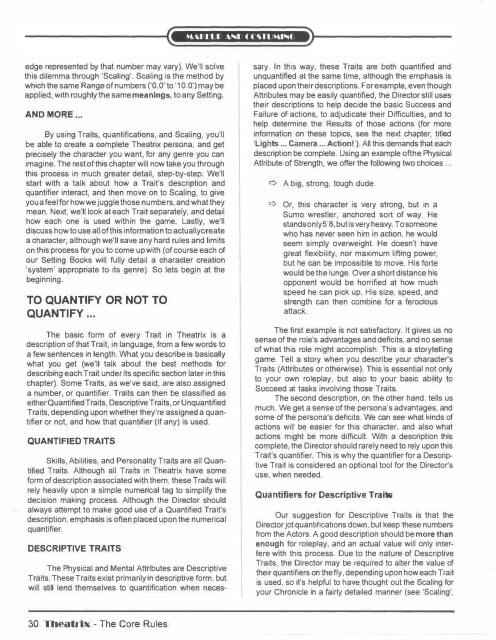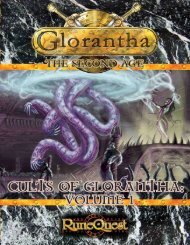Untitled - Index of - Free
Untitled - Index of - Free
Untitled - Index of - Free
Create successful ePaper yourself
Turn your PDF publications into a flip-book with our unique Google optimized e-Paper software.
edge represented by that number may vary). We'll solve<br />
this dilemma through 'Scaling'. Scaling is the method by<br />
which the same Range <strong>of</strong> numbers ('0.0' to '10.0') may be<br />
applied, with roughly the same meanings, to any Setting.<br />
AND MORE ...<br />
By using Traits, quantifications, and Scaling, you'll<br />
be able to create a complete Theatrix persona, and get<br />
precisely the character you want, for any genre you can<br />
imagine. The rest <strong>of</strong> this chapter will now take you through<br />
this process in much greater detail, step-by-step. We'll<br />
start with a talk about how a Trait's description and<br />
quantifier interact, and then move on to Scaling, to give<br />
you a feel for how we juggle those numbers, and what they<br />
mean. Next, we'll look at each Trait separately, and detail<br />
how each one is used within the game. Lastly, we'll<br />
discuss how to use all <strong>of</strong> this information to actuallycreate<br />
a character, although we'll save any hard rules and limits<br />
on this process for you to come up with (<strong>of</strong> course each <strong>of</strong><br />
our Setting Books will fully detail a character creation<br />
'system' appropriate to its genre). So lets begin at the<br />
beginning.<br />
TO QUANTIFY OR NOT TO<br />
QUANTIFY ...<br />
The basic form <strong>of</strong> every Trait in Theatrix is a<br />
description <strong>of</strong> that Trait, in language, from a few words to<br />
a few sentences in length. What you describe is basically<br />
what you get (we'll talk about the best methods for<br />
describing each Trait under its specific section later in this<br />
chapter). Some Traits, as we've said, are also assigned<br />
a number, or quantifier. Traits can then be classified as<br />
either Quantified Traits, Descriptive Traits, or Unquantified<br />
Traits, depending upon whether they're assigned a quan<br />
tifier or not, and how that quantifier (if any) is used.<br />
QUANTIFIED TRAITS<br />
Skills, Abilities, and Personality Traits are all Quan<br />
tified Traits. Although all Traits in Theatrix have some<br />
form <strong>of</strong> description associated with them, these Traits will<br />
rely heavily upon a simple numerical tag to simplify the<br />
decision making process. Although the Director should<br />
always attempt to make good use <strong>of</strong> a Quantified Trait's<br />
description, emphasis is <strong>of</strong>ten placed upon the numerical<br />
quantifier.<br />
DESCRIPTIVE TRAITS<br />
The Physical and Mental Attributes are Descriptive<br />
Traits. These Traits exist primarily in descriptive form, but<br />
will still lend themselves to quantification when neces-<br />
30 Theatrix- The Core Rules<br />
sary. In this way, these Traits are both quantified and<br />
unquantified at the same time, although the emphasis is<br />
placed upon their descriptions. For example, even though<br />
Attributes may be easily quantified, the Director still uses<br />
their descriptions to help decide the basic Success and<br />
Failure <strong>of</strong> actions, to adjudicate their Difficulties, and to<br />
help determine the Results <strong>of</strong> those actions (for more<br />
information on these topics, see the next chapter, titled<br />
'Lights ... Camera ... Action!'). All this demands that each<br />
description be complete. Using an example <strong>of</strong>the Physical<br />
Attribute <strong>of</strong> Strength, we <strong>of</strong>fer the following two choices ...<br />
¢ A big, strong, tough dude.<br />
¢ Or, this character is very strong, but in a<br />
Sumo wrestler, anchored sort <strong>of</strong> way. He<br />
stands only 5'8, but is very heavy. To someone<br />
who has never seen hlm in action, he would<br />
seem simply overweight. He doesn't have<br />
great flexibility, nor maximum lifting power,<br />
but he can be impossible to move. His forte<br />
would be the lunge. Over a short distance his<br />
opponent would be horrified at how much<br />
speed he can pick up. His size, speed, and<br />
strength can then combine for a ferocious<br />
attack.<br />
The first example is not satisfactory. It gives us no<br />
sense <strong>of</strong> the role's advantages and deficits, and no sense<br />
<strong>of</strong> what this role might accomplish. This is a storytelling<br />
game. Tell a story when you describe your character's<br />
Traits (Attributes or otherwise). This is essential not only<br />
to your own roleplay, but also to your basic ability to<br />
Succeed at tasks involving those Traits.<br />
The second description, on the other hand, tells us<br />
much. We get a sense <strong>of</strong> the persona's advantages, and<br />
some <strong>of</strong> the persona's deficits. We can see what kinds <strong>of</strong><br />
actions will be easier for this character, and also what<br />
actions might be more difficult. With a description this<br />
complete, the Director should rarely need to rely upon this<br />
Trait's quantifier. This is why the quantifier for a Descrip<br />
tive Trait is considered an optional tool for the Director's<br />
use, when needed.<br />
Quantifiers for Descriptive Traits<br />
Our suggestion for Descriptive Traits is that the<br />
Director jot quantifications down, but keep these numbers<br />
from the Actors. A good description should be more than<br />
enough for roleplay, and an actual value will only inter<br />
fere with this process. Due to the nature <strong>of</strong> Descriptive<br />
Traits, the Director may be required to alter the value <strong>of</strong><br />
their quantifiers on the fly, depending upon how each Trait<br />
is used, so it's helpful to have thought out the Scaling for<br />
your Chronicle in a fairly detailed manner (see 'Scaling',



